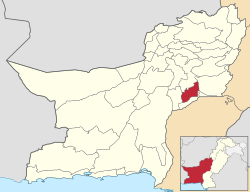Nasirabad District
District of Balochistan in Pakistan From Wikipedia, the free encyclopedia
Nasirabad or Naseerabad (Urdu: ضلع نصیر آباد) is a district of Nasirabad Division[3] in Balochistan, Pakistan. The District was notified in 1974 by separating from Kalat District. For three years, it was called Tamboo District from July 1987 to December 1990, The district's headquarters are located at Dera Murad Jamali.This District is name after Naseer Ahmad who served there Deputy Commissioner and later became Commissioner of the Nasirabad Division.According to 2023 Pakistani census population of Nasirabad District is 565,315.[4]
Naseerabad District
ضلع نصیر آباد | |
|---|---|
 Map of Balochistan with Nasirabad District highlighted | |
| Country | Pakistan |
| Province | Balochistan |
| Division | Nasirabad |
| Established | 1974 |
| Named after | Mir Nasir Khan I |
| Headquarters | Dera Murad Jamali |
| Administrative Tehsil | 06
|
| Government | |
| • Type | District Administration |
| • Deputy Commissioner | Munir Ahmed Khan Kakar |
| • Constituensy | NA-254 Nasirabad-cum-Kachhi-cum-Jhal Magsi |
| • National Assembly Member | Khalid Hussain Magsi (BAP) |
| Area | |
| 3,387 km2 (1,308 sq mi) | |
| Elevation | 67 m (220 ft) |
| Population (2023)[1] | |
| 563,315 | |
| • Density | 170/km2 (430/sq mi) |
| • Urban | 106,952 (19.7%) |
| • Rural | 456,363 |
| Literacy | |
| • Literacy rate |
|
| Time zone | UTC+05:00 (PKT) |
| • Summer (DST) | DST is not observed |
| ZIP Code | |
| NWD (area) code | 0838 |
| ISO 3166 code | PK-BA |
| CNIC Code Nasirabad District | 53402-XXXXXXX-X |
History
The division is named after the Khan of Kalat, Mir Nasir Khan I, who was one of the most respected rulers of Kalat; he ruled Kalat from (1747-1794), and founded the Brahvi-Baloch Confederation, with its center in Khanate of Kalat.[5]
Nasirabad District was first part of state of Kalat until the formation of Kalat District on February 3, 1954. Nasirabad was then separated from Kalat district in 1974, while in 1987 the new district of Jafarabad was cleaved out of it.[6] For three years, from July 1987 to December 1990, it was known as Tahseel Tamboo. Tamboo is a small village 40 km west of Dera Murad Jamali.[7] This District is named after Naseer Ahmed who served there as Deputy commissioner and later became Commissioner of Naseerabad Division.
Administrative divisions
Summarize
Perspective
Tehsils
The district is administratively subdivided into four Tehsils, these are:[8]
| Tehsil | Area
(km²)[9] |
Pop.
(2023) |
Density
(ppl/km²) (2023) |
Literacy rate
(2023)[10] |
Union Councils |
|---|---|---|---|---|---|
| Baba Kot Tehsil | 967 | 53,661 | 55.49 | 15.41% | ... |
| Dera Murad Jamali | 281 | 265,822 | 945.99 | 34.93% | ... |
| Landhi Tehsil | 266 | 8,638 | 32.47 | 17.60% | ... |
| Chattar Tehsil | 961 | 32,276 | 33.59 | 17.21% | ... |
| Meer Hassan Tesil | 229 | 53,400 | 233.19 | 22.99% | ... |
| Tamboo Tehsil | 683 | 149,518 | 218.91 | 28.80% | ... |
Union councils
These tehsils are further divided into union councils. Currently, there are 31 union councils and one municipal committee in the district:
Tehsil Dera Murad Jamali
- Municipal Committee Dera Murad Jamali
- Union Council Quba Sher Khan Sharqi
- Union Council Quba Sher Khan Gharbi
- Union Council Naseer Khan Umrani
- Union Council Jhuder Shimali
- Union Council Bedar Androon Sharqi
- Union Council Bedar Gharbi
- Union Council Manjhoti Sharqi
- Union Council Sardar Shahzada Khan Umrani
- Union Council Sikandarabad
- Union Council Manjhoti Gharbi
- Union Council Jhuder Janubi
Tehsil Chhatter
- Union Council Chhatter
- Union Council Phuleji
- Union Council Shah Pur
- Union Council Daulat Ghari Mir Nabi Bakhsh Khan
- Union Council Daulat Ghari Mir Hassan Khosa
- Union Council Shori Drabi
Tehsil Tamboo
- Union Council Manjhoo Shoori
- Union Council Aeri
- Union Council Gola Wah
- Union Council Ali Abad Shumali
- Union Council Mir Behram Khan Buledi
- Union Council Qadir Abad
- Union Council Kharoos Wah
- Union Council Fateh Mohammad
- Union Council Mir Wah
- Union Council Abdullah Bari
- Union Council Ali Abad
Tehsil Baba Kot
- Union Council Garhi Rehman
- Union Council Baba Kot
- Union Council Kuhna Tamboo
Demographics
Summarize
Perspective
| Year | Pop. | ±% p.a. |
|---|---|---|
| 1951 | N/A | — |
| 1961 | N/A | — |
| 1972 | N/A | — |
| 1981 | N/A | — |
| 1998 | 245,894 | — |
| 2017 | 487,847 | +3.67% |
| 2023 | 563,315 | +2.43% |
| Sources:[11] | ||
Population
As of the 2023 census, Nasirabad district has 87,516 households and a population of 563,315. The district has a sex ratio of 104.54 males to 100 females and a literacy rate of 28.96%: 36.43% for males and 21.18% for females.[12][13] 216,847 (38.49% of the surveyed population) are under 10 years of age.[14] 106,952 (18.99%) live in urban areas.[12]
Religion
Islam is the largest religion. Hinduism is a minority religion while Christianity has around 1,400 followers in the district.
Language
At the time of the 2023 census, 43.21% of the population spoke Balochi, 22.27% Brahui, 21.16% Sindhi and 12.15% Saraiki as their first language.[1]
References
Bibliography
External links
Wikiwand - on
Seamless Wikipedia browsing. On steroids.
